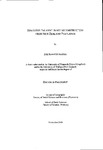HOLOCENE PALAEOCLIMATE RECONSTRUCTION FROM N EW ZEALAND PEATLANDS
| dc.contributor.author | HAZELL, ZOE JENNIFER | |
| dc.contributor.other | Faculty of Science and Engineering | en_US |
| dc.date.accessioned | 2013-09-18T12:09:01Z | |
| dc.date.available | 2013-09-18T12:09:01Z | |
| dc.date.issued | 2004 | |
| dc.identifier | NOT AVAILABLE | en_US |
| dc.identifier.uri | http://hdl.handle.net/10026.1/1853 | |
| dc.description.abstract |
A selection of palaeoecological proxies were tested on two raised, ombrotrophic, restiad peat bog sites from the North Island of New Zealand. With varying degrees of success, peat humification, testate amoebae, plant macrofossil and charcoal analyses contributed to determining the palaeomoisture records from three cores on each site. Climatic inferences have successfully been made for the Waikato region, mid North Island, over the period between the Tuhua (6,130±30 14C years BP; 6,800-7,150 cal. years BP) and Taupo (1,850±10 14C years BP; 1,650-1,800 cal. years BP) tephras. 47 AMS radiocarbon ages contributed to the production of age-depth models. The peat humification records have a resolution of 20-30 years and are the first replicated records for this region. Whilst peat humification and charcoal were the most successful analyses, the limited plant macrofossil work has also shown potential. Testate amoebae analysis, however, was not appropriate for these particular sites due to extremely low fossil test abundances. From the peat humification record, the main palaeomoisture trend identified in all cores is a shift towards wetter conditions c.5,000-4,000 cal. years BP. This is thought to have resulted from stronger westerly circulation, driven by increasing temperature and pressure gradients across the Southern Ocean from equatorial to polar latitudes. This in turn is likely to have been due to an increasing differential between insolation received at these latitudes, ultimately forced by the precessional cycle. The 'Mid-Holocene Transition' to wet conditions appears to contradict previous work from New Zealand that infers a drier late Holocene. This apparent contradiction can, however, be reconciled by increasing seasonality that would also explain the rise in charcoal abundance following the Mid-Holocene Transition. Colder, wetter winters resulted from decreasing winter (June) insolation and stronger rain-bearing westerlies, causing a decrease in peat humification. Warmer, drier summers resulted from an increase in summer (December) insolation and caused increased regional burning. An intensifying ENSO signal at the mid-Holocene is also thought to be responsible for increased drought occurrence and weather extremes. | en_US |
| dc.language.iso | en | en_US |
| dc.publisher | University of Plymouth | en_US |
| dc.title | HOLOCENE PALAEOCLIMATE RECONSTRUCTION FROM N EW ZEALAND PEATLANDS | en_US |
| dc.type | Thesis | |
| plymouth.version | Full version | en_US |
| dc.identifier.doi | http://dx.doi.org/10.24382/1525 |
Files in this item
This item appears in the following Collection(s)
-
01 Research Theses Main Collection
Research Theses Main


